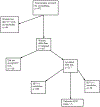Predictors of HIV seropositivity following intrapartum voluntary counseling and testing among Rwandan women
- PMID: 14617465
- PMCID: PMC6784824
- DOI: 10.1080/01443610310001604402
Predictors of HIV seropositivity following intrapartum voluntary counseling and testing among Rwandan women
Abstract
We investigated risk factors associated with HIV infection in women who accepted voluntary counselling and testing (VCT) intrapartum. A survey questionnaire containing information on sociodemographic characteristics was administered to parturients at the Central Hospital Kigali after informed consent had been obtained. Participants were then offered VCT for HIV, and those who accepted were informed of their results. Of the 427 eligible participants, 317 accepted VCT (74.2%). The results of 312 (98.4%) of these women were obtained and 50 tested positive for HIV, yielding an HIV seroprevalence of 16.0% intrapartum. Women who had been pregnant three or more times were three times as likely to test positive for HIV in comparison to those of lower parity (OR=2.9; 95% confidence interval (CI)=1.1 - 8.0). This finding contradicts earlier studies performed antenatally among women of childbearing age and pregnant women in general. This may be attributable to some inadequacy in the existing health-care infrastructure to effectively detect HIV in multiparous women antenatally, or may represent a signal that a change in the nature of the epidemic in Rwanda is occurring.
Figures
Similar articles
-
Voluntary counseling and testing for HIV among pregnant women presenting in labor in Kigali, Rwanda.J Acquir Immune Defic Syndr. 2002 Dec 1;31(4):408-15. doi: 10.1097/00126334-200212010-00007. J Acquir Immune Defic Syndr. 2002. PMID: 12447012
-
Acceptance of HIV-1 education & voluntary counselling/testing by & seroprevalence of HIV-1 among, pregnant women in rural south India.Indian J Med Res. 2007 Jan;125(1):49-64. Indian J Med Res. 2007. PMID: 17332657
-
High burden of prevalent and recently acquired HIV among female sex workers and female HIV voluntary testing center clients in Kigali, Rwanda.PLoS One. 2011;6(9):e24321. doi: 10.1371/journal.pone.0024321. Epub 2011 Sep 19. PLoS One. 2011. PMID: 21949704 Free PMC article.
-
Risk factors for HIV infection among asymptomatic pregnant women attending an antenatal clinic in western Kenya.Int J STD AIDS. 2000 Jun;11(6):393-401. doi: 10.1258/0956462001916119. Int J STD AIDS. 2000. PMID: 10872913
-
A cohort study of factors associated with failure to return for HIV post-test counselling in pregnant women: Kigali, Rwanda, 1992-1993.AIDS. 1996 Jan;10(1):69-75. doi: 10.1097/00002030-199601000-00010. AIDS. 1996. PMID: 8924254
Cited by
-
Rapid screening for co-infection of HIV and HCV in pregnant women in Benin City, Edo State, Nigeria.Afr Health Sci. 2009 Sep;9(3):137-42. Afr Health Sci. 2009. PMID: 20589140 Free PMC article.
-
Rural Indian tribal communities: an emerging high-risk group for HIV/AIDS.BMC Int Health Hum Rights. 2005 Feb 21;5(1):1. doi: 10.1186/1472-698X-5-1. BMC Int Health Hum Rights. 2005. PMID: 15723696 Free PMC article.
-
Factors associated with utilization of a free HIV VCT clinic by female sex workers in Jinan City, Northern China.AIDS Behav. 2011 May;15(4):702-10. doi: 10.1007/s10461-010-9703-2. AIDS Behav. 2011. PMID: 20458528 Free PMC article.
References
-
- Adamu YM and Salihu HM (2002) Barriers to the use of antenatal and obstetric care services in rural Kano, Nigeria. Journal of Obstetrics and Gynecology, 22, 600 – 603. - PubMed
-
- Allen S, Lindan C, Serufilira A, Van de Perre P, Rundle AC, Nsengumureyi F, Carael M, Schwalbe J and Hulley S (1991) Human immunodeficiency virus infection in urban Rwanda; demographic and behavioral correlates in a representative sample of childbearing women. Journal of the American Medical Association, 266, 1657 – 1663. - PubMed
-
- Chao A, Bulterys M, Musanganire F, Habimana P, Nawrocki P, Taylor E, Dushimimana A and Saah A (1994) Risk factors associated with prevalent HIV-1 infection among pregnant women in Rwanda. International Journal of Epidemiology, 23, 371 – 380. - PubMed
-
- Falloon J, Eddy J, Wiener L and Pizzo PA (1989) Human immunodeficiency virus infection in children. Journal of Pediatrics, 114, 1 – 30. - PubMed
-
- Guay LA, Musoke P, Flemming T, Bagenda D, Allen M, Nakabiito C and Sherman J (1999) Intrapartum and neonatal single-dose nevirapine compared with zidovudine for prevention of mother-to-child transmission of HIV-1 in Kampala, Uganda: HIVNET 012 randomised trial. Lancet, 354, 795 – 802. - PubMed
Publication types
MeSH terms
Grants and funding
LinkOut - more resources
Full Text Sources
Medical


